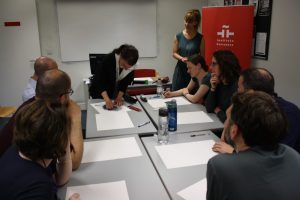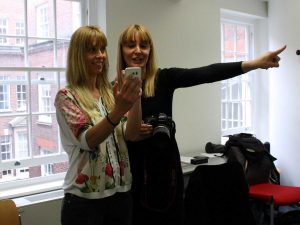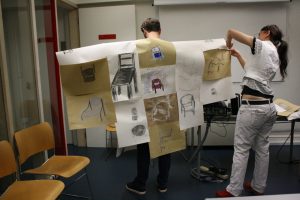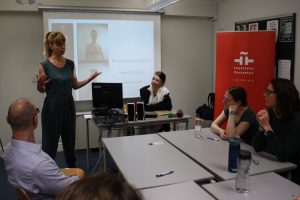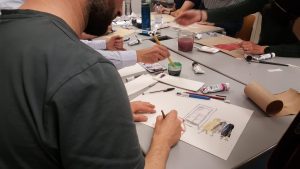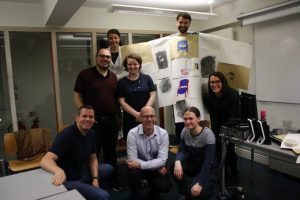Teaching Spanish through art: the way of learning of the Zeta Generation
This week at the Instituto Cervantes in London, two artistic workshops on identity and gender will star in the «Making Art Happen» project. The classes will run in Spanish in order to integrate the creative process with our classroom methodology.
The project, directed by the cultural mediator Vanesa Cejudo and with the participation of the artists Isabel Castro Jung and Susana Sanromán, was born in 2017 with the aim of «taking the doctoral theses out of the boxes» and launching an exercise of pedagogical innovation.
«Making Art Happen» is an initiative supported by the Ministry of Culture, the Madrid City’s Council and Caja Navarra through the aid of Innova Culture. It aims to think about a subject (in this case, Spanish) and re-imagine it through art and its process.
«The objective is to design a methodology among the teacher, the artist and the cultural mediator for students to learn through art. This has a fundamental objective, which is to engage the Zeta generation, a generation that learns in a very different way from the traditional one, which has many sources of information, an important line of self-training and a lower level of attention than previous generations » says Cejudo.
In practice, this translates into the incorporation of more active methodologies, where the student is invited to think, to move in the classroom, to engage in dialogues, to generate dynamics with other colleagues, to contrast opinions, and finally, to materialize a work based or inspired by the guest artist.
«We want students to participate in the artistic process and to learn the subject at the same time. It is a challenge, but it is also something that we have been asked from the educational institutions to incorporate into the classroom «, explains Cejudo.
This experience, which celebrates its second edition at the Instituto Cervantes in London after the installation of Isidro López Aparicio last year, is «very exciting» in its expression, explains Cejudo.
On the one hand, this project aims to help students see contemporary art as something with which they can represent themselves. On the other, to teach them about the dynamic between the teacher and the artist: «the meeting of two worlds that go in parallel and yet coincide in similar themes».
In the workshop with Isabel Castro Jung, she will address the question of identity. Identity is a key to the work of the artist; daughter of a German mother and Galician father, and who finds «many parallels between learning to draw and learning the language».
In the case of the Galician photographer Susana Sanromán, it was very important that the students did not take the photos themselves, but that they recreated and built a set design. Both projects want to offer students the possibility of working in a different environment, where the objective is to combine verbal and rational language with the reconstruction and analysis offered by the visual world. And all through the uniting medium of the Spanish language.
Enseñar español a través del arte: la manera de aprender de la Generación Zeta
Dos talleres artísticos de identidad y género, dentro del proyecto “Making Art Happen”, protagonizaron las clases de español esta semana en el Instituto Cervantes de Londres, con el fin de integrar el proceso creativo dentro de la metodología del aula.
El proyecto, dirigido por la mediadora cultural Vanesa Cejudo y con la participación de las artistas Isabel Castro Jung y Susana Sanromán, nació en 2017 con el empeño de “sacar de los cajones las tesis doctorales” y poner en marcha un ejercicio de innovación pedagógica.
En “Making Art Happen”, iniciativa apoyada por el Ministerio de Cultura, el Ayuntamiento de Madrid y Caja Navarra a través de las ayudas de Innova Cultura, se propone pensar una asignatura, en este caso el español, mediante el arte y su proceso.
Generación Zeta
“El objetivo es diseñar entre el profesor, el artista y el mediador cultural una metodología para que los estudiantes aprendan a través del arte. Esto tiene un objetivo fundamental, que es enganchar a la generación Zeta, una generación que aprende de una manera muy diferente a la tradicional, que tiene muchísimas fuentes de información, una línea de autoformación importante y un nivel de atención menor al de generaciones previas”, comenta Cejudo.
En la práctica, esto se traduce en la incorporación de metodologías más activas, en donde el estudiante se ve invitado a pensar, a moverse en el aula, a dialogar, a generar dinámicas con otros compañeros, a contrastar opiniones, y por último, a materializar una obra basada o inspirada en el artista invitado.
“Buscamos que los alumnos participen del proceso artístico y que aprendan la asignatura a la vez. Es un reto, pero también es algo que nos han pedido desde las instituciones educativas para incorporar en el aula”, explica Cejudo.
Esta experiencia, que cumple su segunda edición en el Instituto Cervantes de Londres tras la instalación de Isidro López Aparicio el año pasado, resulta “muy emocionante” en su plasmación, explica Cejudo. Por un lado, por parte de unos estudiantes que pasan a ver el arte contemporáneo como algo que les afecta y en lo que se pueden sentir representados. Por otro, por “el encuentro de dos mundos que van en paralelo y sin embargo coinciden en temáticas afines”: el profesor y el artista.
Talleres de identidad y género
En el taller con Isabel Castro Jung se ha trabajado la cuestión de la identidad por ser clave en la obra de la artista, hija de madre alemana y padre gallego, y que encuentra “muchos paralelismos entre aprender a dibujar y el aprendizaje del idioma”.
En el caso de la fotógrafa gallega Susana Sanromán ha sido muy importante que los alumnos no hicieran ellos mismos la foto, sino que recrearan y construyeran una escenografía. Ambos proyectos quieren ofrecer a los alumnos la posibilidad de trabajar en un entorno diferente del habitual, donde el objetivo es combinar el lenguaje verbal y racional con la reconstrucción y análisis que nos ofrece el mundo visual. Y todo ello, aprendiendo español.
